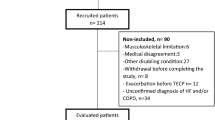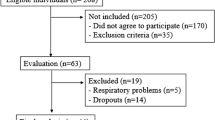Abstract
Background/Objectives
Different approaches are used to classify obesity severity. Beyond classical anthropometric measurements, the Edmonton Obesity Staging System (EOSS) considers medical, physical and psychological parameters. However, this method has some limitations, principally due to the absence of an objective measure for physical impairment. The aim of our study is thus to overcome this limitation suggesting a new functional parameter obtained by cardiopulmonary exercise testing (CPET), i.e., cardiorespiratory fitness (CRF), expressed as weight-adjusted peak oxygen consumption (VO2peak/kg).
Subjects/Methods
This observational cross-sectional study conducted on a population of 843 patients affected by obesity finally enrolled 500 subjects. Every patient underwent clinical, anthropometric, biochemical assessment and CPET. First, participants have been classified according to standard EOSS in five stages. Second, patients were reclassified according to the new modified EOSS (EOSS-CRF) based on their age- and gender-appropriate VO2peak/kg percentiles as reported in the healthy normal-weight population of the FRIEND registry.
Results
VO2peak/kg was significantly different between standard EOSS classes 1 and 2 and classes 1 and 3 (ANCOVA p model = 0.004), whereas patients in classes 2 and 3 showed similar CRF. The EOSS-CRF classification varied in number of patients in each class compared to EOSS, particularly with a shift from class 2 to class 3. Moreover, CRF showed that physical impairment is less addressed by EOSS when compared to EOSS-CRF.
Conclusions
The integration of EOSS with CRF allowed us to assign to each patient a severity index that considers not only clinical parameters, but also their functional impairment through a quantitative and prognostically important parameter (VO2peak/kg). This improvement of the staging system may also provide a better approach to identify individuals at increased risk of mortality leading to targeted therapeutic management and prognostic risk stratification for patients with obesity.
This is a preview of subscription content, access via your institution
Access options
Subscribe to this journal
Receive 12 print issues and online access
$259.00 per year
only $21.58 per issue
Buy this article
- Purchase on Springer Link
- Instant access to full article PDF
Prices may be subject to local taxes which are calculated during checkout





Similar content being viewed by others

References
Global Burden of Disease Collaborative Network. Global burden of disease study 2015 (GBD 2015) obesity and overweight prevalence 1980–2015. Seattle, United States Institute for Health Metrics and Evaluation 2017.
Bray GA, Kim KK, Wilding JPH. Obesity: a chronic relapsing progressive disease process. A position statement of the World Obesity Federation. Obes Rev. 2017;18:715–23.
Bhaskaran K, dos-Santos-Silva I, Leon DA, Douglas IJ, Smeeth L. Association of BMI with overall and cause-specific mortality: a population-based cohort study of 3·6 million adults in the UK. Lancet Diabetes Endocrinol. 2018;6:944–53.
Gallagher D, Heymsfield SB, Heo M, Jebb SA, Murgatroyd PR, Sakamoto Y. Healthy percentage body fat ranges: an approach for developing guidelines based on body mass index. Am J Clin Nutr. 2000;72:694–701.
Pischon T, Boeing H, Hoffmann K, Bergmann M, Schulze MB, Overvad K, et al. General and abdominal adiposity and risk of death in Europe. N Engl J Med. 2008;359:2105–20.
Santini F, Busetto L, Cresci B, Sbraccia P. SIO management algorithm for patients with overweight or obesity: consensus statement of the Italian Society for Obesity (SIO). Eat Weight Disord. 2016;21:305–7.
Rubino F, Puhl RM, Cummings DE, Eckel RH, Ryan DH, Mechanick JI, et al. Joint international consensus statement for ending stigma of obesity. Nat Med. 2020;26:485–97.
Sharma AM, Kushner RF. A proposed clinical staging system for obesity. Int J Obes. 2009;33:289–95.
Kuk JL, Ardern CI, Church TS, Sharma AM, Padwal R, Sui X, et al. Edmonton Obesity Staging System: association with weight history and mortality risk. Appl Physiol Nutr Metab. 2011;36:570–6.
Padwal RS, Pajewski NM, Allison DB, Sharma AM. Using the Edmonton Obesity Staging System to predict mortality in a population-representative cohort of people with overweight and obesity. CMAJ. 2011;183:1059–66.
Ejima K, Xavier NA, Mehta T. Comparing the ability of two comprehensive clinical staging systems to predict mortality: EOSS and CMDS. Obesity. 2020;28:353–61.
Blair SN, Kohl HW, Paffenbarger RS, Clark DG, Cooper KH, Gibbons LW. Physical fitness and all-cause mortality. JAMA. 1989;262:2395.
Myers J, Prakash M, Froelicher V, Do D, Partington S, Edwin Atwood J. Exercise capacity and mortality among men referred for exercise testing. N Engl J Med. 2002;346:793–801.
Rabiee R, Agardh E, Kjellberg K, Falkstedt D. Low cardiorespiratory fitness in young adulthood and future risk of disability pension: A follow-up study until 59 years of age in Swedish men. J Epidemiol Community Health. 2015;69:266–71.
Ross R, Blair SN, Arena R, Church TS, Després JP, Franklin BA, et al. Importance of assessing cardiorespiratory fitness in clinical practice: a case for fitness as a clinical vital sign: a scientific statement from the American Heart Association. Circulation. 2016;134:e653–99.
Yumuk V, Tsigos C, Fried M, Schindler K, Busetto L, Micic D, et al. European guidelines for obesity management in adults. Obes Facts. 2015;8:402–24.
Bairaktari ET, Seferiadis KI, Elisaf MS. Evaluation of methods for the measurement of low-density lipoprotein cholesterol. J Cardiovasc Pharmacol Ther. 2005;10:45–54.
Cosentino F, Grant PJ, Aboyans V, Bailey CJ, Ceriello A, Delgado V, et al. 2019 ESC Guidelines on diabetes, pre-diabetes, and cardiovascular diseases developed in collaboration with the EASD. Eur Heart J. 2020;41:255–323.
Matthews DR, Hosker JP, Rudenski AS, Naylor BA, Treacher DF, Turner RC. Homeostasis model assessment: insulin resistance and?-cell function from fasting plasma glucose and insulin concentrations in man. Diabetologia. 1985;28:412–9.
Borg GA. Psychophysical bases of perceived exertion. Med Sci Sports Exerc. 1982;14:377–81.
Balady GJ, Arena R, Sietsema K, Myers J, Coke L, Fletcher GF, et al. Clinician’s guide to cardiopulmonary exercise testing in adults: a scientific statement from the American Heart Association. Circulation. 2010;122:191–225.
Fletcher GF, Ades PA, Kligfield P, Arena R, Balady GJ, Bittner VA, et al. Exercise standards for testing and training. Circulation. 2013;128:873–934.
Baba R, Nagashima M, Goto M, Nagano Y, Yokota M, Tauchi N, et al. Oxygen uptake efficiency slope: a new index of cardiorespiratory functional reserve derived from the relation between oxygen uptake and minute ventilation during incremental exercise. J Am Coll Cardiol. 1996;28:1567–72.
Kaminsky LA, Arena R, Myers J. Reference standards for cardiorespiratory fitness measured with cardiopulmonary exercise testing data from the fitness registry and the importance of exercise national database. Mayo Clin Proc. 2015;90:1515–23.
Mancia G, De Backer G, Dominiczak A, Cifkova R, Fagard R, Germano G, et al. Guidelines for the management of arterial hypertension: The Task Force for the Management of Arterial Hypertension of the European Society of Hypertension (ESH) and of the European Society of Cardiology (ESC). 2007 https://doi.org/10.1097/HJH.0b013e3281fc975a.
Mach F, Baigent C, Catapano AL, Koskinas KC, Casula M, Badimon L, et al. 2019 ESC/EAS Guidelines for the management of dyslipidaemias: lipid modification to reduce cardiovascular risk. Eur Heart J. 2020;41:111–88.
Sateia MJ. International classification of sleep disorders-third edition. Chest. 2014;146:1387–94.
Marchesini G, Day CP, Dufour JF, Canbay A, Nobili V, Ratziu V, et al. EASL-EASD-EASO clinical practice guidelines for the management of non-alcoholic fatty liver disease. Obes Facts. 2016;9:65–90.
Chalasani N, Younossi Z, Lavine JE, Charlton M, Cusi K, Rinella M, et al. The diagnosis and management of nonalcoholic fatty liver disease: practice guidance from the American Association for the Study of Liver Diseases. Hepatology. 2018;67:328–57.
Canning KL, Brown RE, Wharton S, Sharma AM, Kuk JL. Edmonton Obesity Staging System prevalence and association with weight loss in a publicly funded referral-based obesity clinic. J Obes. 2015;2015. https://doi.org/10.1155/2015/619734.
Guazzi M, Adams V, Conraads V, Halle M, Mezzani A, Vanhees L, et al. Clinical recommendations for cardiopulmonary exercise testing data assessment in specific patient populations. Circulation. 2012;126:2261–74.
Mehra MR, Jessup M, Gronda E, Costanzo MR. Rationale and process: International Society for Heart and Lung Transplantation guidelines for the care of cardiac transplant candidates-2006. J Hear Lung Transplant. 2006;25:1001–2.
Malhotra R, Bakken K, D’Elia E, Lewis GD. Cardiopulmonary exercise testing in heart failure. JACC Hear Fail. 2016;4:607–16.
Swift DL, Lavie CJ, Johannsen NM, Arena R, Earnest CP, O’Keefe JH, et al. Physical activity, cardiorespiratory fitness, and exercise training in primary and secondary coronary prevention. Circ J. 2013;77:281–92.
Wasserman K, Hansen J, Sue D, Stringer W, Sietsema K, Sun X et al. Principles of exercise testing and interpretation. 5th ed. Philadelphia: Lippincott Williams & Wilkins; 2012.
Weisman IM, Weisman IM, Marciniuk D, Martinez FJ, Sciurba F, Sue D, et al. ATS/ACCP Statement on cardiopulmonary exercise testing. Am J Respir Crit Care Med. 2003;167:211–77.
Author information
Authors and Affiliations
Corresponding author
Ethics declarations
Conflict of interest
The authors declare no competing interests.
Additional information
Publisher’s note Springer Nature remains neutral with regard to jurisdictional claims in published maps and institutional affiliations.
Rights and permissions
About this article
Cite this article
Bettini, S., Quinto, G., Neunhaeuserer, D. et al. Edmonton Obesity Staging System: an improvement by cardiopulmonary exercise testing. Int J Obes 45, 1949–1957 (2021). https://doi.org/10.1038/s41366-021-00856-9
Received:
Revised:
Accepted:
Published:
Issue Date:
DOI: https://doi.org/10.1038/s41366-021-00856-9
This article is cited by
-
Updating obesity management strategies: an audit of Italian specialists
Eating and Weight Disorders - Studies on Anorexia, Bulimia and Obesity (2022)


